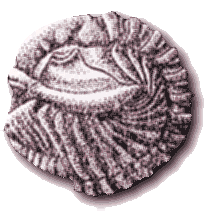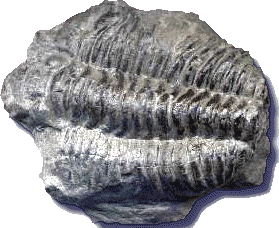Geology / Gallery

Calymene blumenbachii (5)
Trilobites ➚ are perhaps the most distinctive Palaeozoic ➚ fossil.
This Silurian trilobite is shown curled up in a ball, the compound eye faces upward, the axial ring forms the 'spine' like ring protecting the animal from predators.
The tail is tucked up beneath the glabella or 'head'. Trilobites have been intensely studied as they have proven so useful in dating Cambrian and Ordovician rocks.

This particular species of Calymene (a fairly common genus in the Ordovician-Silurian) is unique to the Wenlock series. This specimen came from the trusty Wenlock Limestone at Shadwell Quarry outside Much Wenlock ➚. This site seems to yield trilobites more readily than any other quarry on Wenlock Edge, and the rock here is dark grey as opposed to yellowish or whitish as it appears on other parts of the Edge just a couple of miles away. This suggests a local change in the environment in which the rock was deposited in. Darker rock often signifies a lower oxygen level in the water, but this seems unlikely since Shadwell produces much larger fossils than most of the Edge.
This trilobite would have spent its life grubbing around the prolific reef systems present at the time when Britian lay at 20 degrees South of the equator, about the same latitude as Northern Australia today - home of the Great Barrier Reef.
This specimen was kindly photographed for us by Merlin
| Division | Name |
| Phylum | Not yet agreed |
| Class | Trilobita |
| Order | Phacopida |
| Suborder | Calymenina |
Fossil gallery
- Brittle Star : Lapworthia miltoni
- Trilobite : Dalmanites myops
- Crinoid : Eucalyptocrinites decorus
- Gastropod : Poleumita discorus
- Trilobite : Calymene blumenbachi
- Graptolite : Cyrtograptus murchisoni
- Sponge : Ischadites koenigi
- Conodont : Ozarkodina typica
- Brachiopod : Pentamerus oblongus
- Graptolite : Petalograptus minor
- Brachiopod : Chonetes striatellus
- Cystoid : Lepocrinetes quadrifasciatus
- Bivalve : Pteronitella retroflexa
- Graptolite : Monograptus lobiferus
- Gastropod : Platyceras haliotis
- Crinoid : Sagenocrinites expansus
- Brachiopod : Atrypa reticularis
